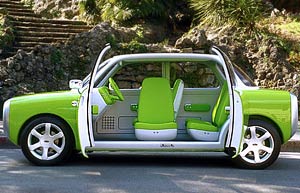
Object of Desire: The GT 40
However: there are an awful lot of us who lust after curvaceous rolling stock, and for so many Camry-dominated years, the only place we've been able to find it is in magazines — or cruising down swank streets like Rodeo Drive.
Now there's change afoot, signaled this week by the Harvard Graduate School of Design, which presented its annual Excellence in Design award to, of all things, a car designer: J Mays, the 47-year-old Oklahoman who has been in charge of car design at Ford since 1997. Mays is a guy whose world is actively about more than cars. Call him the auto industry equivalent of a cross-dresser, because he's a serious advocate of good fashion, product design and architecture, and doesn't mind dissing his own industry's shortcomings. His approach has begun to draw a following that extends beyond the auto industry into the entire design world. The Harvard award effectively validates that.
Mays made a name for himself as the guy behind the cuddly Volkswagen New Beetle, which is both mod and familiar (the Old Beetle); the Ford Thunderbird, which is...also mod and familiar (the '56 T-Bird). He takes his cue from the notion that you can't move forward without looking over your shoulder, and his popular designs in recent years have ignited a chorus of "Retro!" Which, he argues, misses the point. It's not just backward, it's about forward.
He's right. It's more complicated than Retro. It's really about emotion, and getting us to say "Wow!" or "Gee!" or more when we see a car. Among the six cars on display at the Design School is one even more inspiring, edgier, riskier, than the T-bird — the Ford '49. It's a dramatic black coupe with a glass roof that is supposed to hark back to the the car Henry Ford introduced in 1949, a hugely popular model that saved the company from post-war extinction.
But the real coup is the GT 40, a redesigned (mod!) version of the Ford Le Mans race car that was big in the late 60s — particularly with Steve McQueen in the John Frankenheimer film, "Le Mans." Ford introduced this new GT40 as a concept car at the Detroit auto show in January. It drew rave reviews and a cascade of calls and emails from interested buyers, including a gang of small businessmen from the East Coast who flew their jet out for a private viewing.
This week, Ford announced it would produce the sexy beast, for anyone with a spare $100K or more in their just-gotta-have-it fund. While that may seem a little strange for an automaker that plays to a mass market, there's a sound reason behind this. Ford is in desperate financial straits, and they needed a button-presser. The GT40 is a limited production car with a price tag high enough that huge profit margins are guaranteed. Limited ownership. Limited liability.

FORD
The O21C |
The GT40 is on display in Cambridge, Mass. as we speak, right there in the lobby of the Harvard Design School, the first car that's ever been there as a work of art. But it's worth thinking about the other vehicle that the curators, Joe MacDonald and Kim Shkapich, asked Ford to display. This is the O21C, a vision of lime green and white that looks like it could be either Judy Jetson's shopmobile or a great little around-town-vehicle for New York, or London, or Tokyo. The O21C was designed, under Mays' supervision, by product designer Marc Newson. It is small, simple and elegant; it could be a perfect mass market city car. And it will never be produced. The reason? It's not mainstream enough. Putting a concept into production is extremely risky given the high cost of tooling up a factory. That's why so many cars on the road look like lowest common denominator mobiles: car companies won't take the risk.
J Mays is pushing toward taking that risk. He and his associates at Volkswagen/Audi and lately at Ford have started a movement among designers to stop listening to focus groups and start thinking about how their creations connect with real people. There are a few more inspiring cars out there these days — the Chrysler PT Cruiser, the Audi TT, and now maybe the Nissan Altima. But when will this be translated to the mass market? The really emotive mobiles — the '49, the GT40, the new Cadillacs — are priced beyond our reach. Toyota is trying. But with all the production technology out there, can't anyone start making a people's car that doesn't make us commoners have to get our thrills from looking at the pictures?
